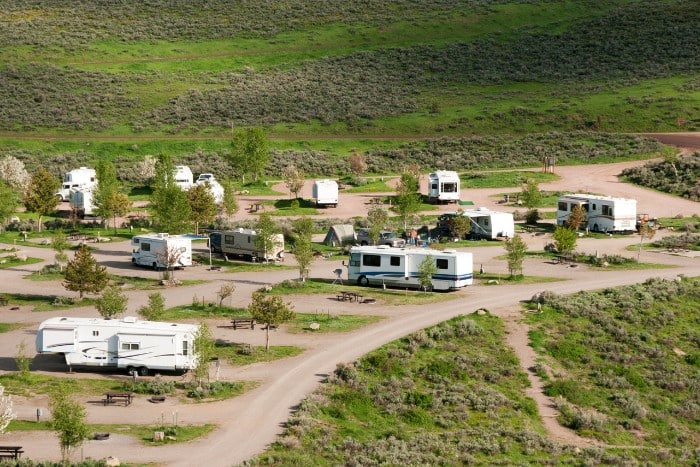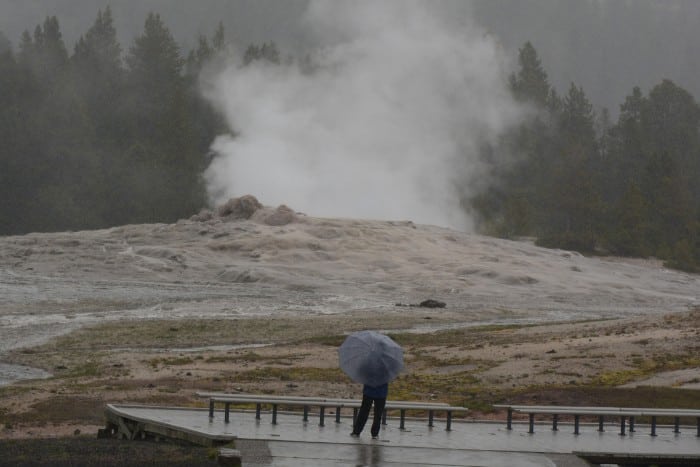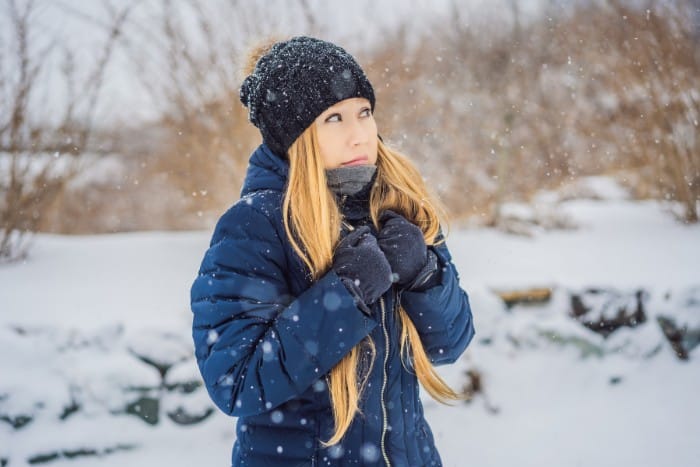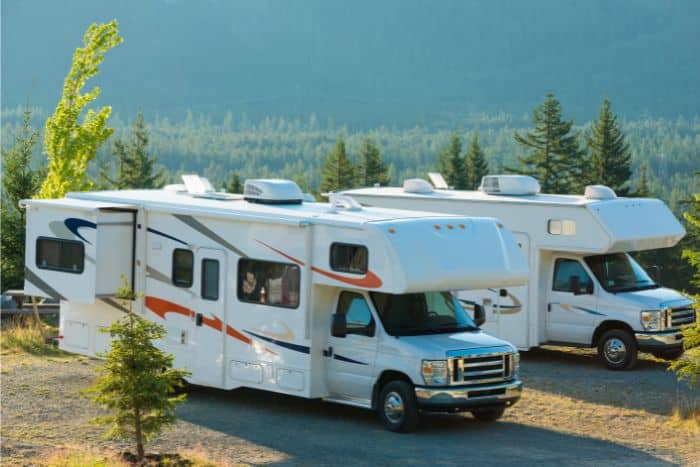Visiting Yellowstone in winter is an out-of-this-world experience, vastly different from a summer stay, and highly recommended. Those who want to immerse themselves completely in nature may wonder if you can still camp in Yellowstone in winter or if it’s completely off-limits.
It is possible to camp in Yellowstone year-round, although safety precautions are a must. Usually, one campground remains open throughout winter, and backcountry camping is always an option. Yellowstone may be the picture of a winter wonderland, but the challenges are not to be underestimated.
Before you pack your bags, read on to find out where and how to camp and what you must be aware of before taking on this challenge.
Yellowstone National Park in Winter
The world’s first national park, Yellowstone’s outstanding beauty and geothermal features have been a magnetic draw for millions of visitors for over a century.
With around 4 million visitors each year, its popularity remains constant.
Yet most choose to visit in the summer when access to facilities is easier and to travel around to the park’s many areas of beauty is relatively simple. Yellowstone in winter is an altogether different beast.
From the end of October to November, the park becomes blanketed in snow (an average of 150 inches falls each year), creating a completely different environment to the summer setting that so many visitors are familiar with.
Rather than the verdant scenery of the Spring, Summer, and Fall months, it becomes a winter wonderland with colorful thermal pools steaming from an icy landscape.
This stark beauty, however, comes with increased complications for visitors. It’s far harder to access the national park in winter when compared to the summer months.
Many roads become impassable and are closed by significant snowfall. Some routes are only accessible by snowmobile or specially designed coaches.
Most campgrounds and accommodation options shut up shop for winter, making it much more difficult to plan a trip. Planning and preparation are vital requirements before you set out.
For many cold-weather visitors, there’s nothing like the stark beauty of a snow-frosted Yellowstone, and visiting at least once is highly recommended.
For those who like a challenge, a camping trip to Yellowstone is still possible, although extremely challenging, and should not be taken lightly.
What Camping is Possible in Yellowstone in Winter?
For those who want to truly experience the elements during a winter trip to Yellowstone, camping under canvas or in your own snow shelter is your best bet.
In theory, it is possible to get out into the beautiful nature of the national park throughout the winter months.
Whether you wish to venture out into the backcountry or want a more protected camping spot, you have two options: a national park campground with facilities or a backcountry location.
1. Mammoth Campground
Although most other campgrounds in Yellowstone National Park close for the winter period at some point between September to November, Mammoth Campground is the one exception that generally remains open year-round for RVs and tents alike.
This may, however, be subject to change if there are extreme conditions.
As of 2022, unfortunately, this campground is also closed due to flooding, so always check the current situation before making concrete plans.
Since Mammoth Campground is the only winter site available, campers should be aware that access to managed camping facilities is far more restricted than in the summer months when there are 12 campgrounds available.
During the on-season months, there are over 2000 tent sites open. In winter, the availability falls drastically to just 85 sites.
Although places can be reserved here from April until October, the campground switches to a first-come, first-served system in winter.
Reservations are not taken, so be sure to arrive early in the day to bag your site, just in case.
Mammoth Campground has basic facilities such as cell reception, food-storage lockers, trash, and recycling collection, potable water, and flush toilets.
There are no showers, however, so you should be aware of this before starting your trip.

2. Backcountry Camping
For those who want to get off the beaten path, backcountry camping is an altogether different experience, allowing you to access an unseen side of Yellowstone that most visitors rarely touch.
Backcountry campers aren’t required to stay at designated camping grounds from December until the start of May, so if you are up for the challenge, you can venture to the furthest reaches of the national park and explore beyond the boundaries of usual routes and trails.
If this is the freedom you’re looking for, you must get a backcountry permit before you set out into the wild.
You can get one online over winter (start of November until mid-May) or in person at the South Entrance (from mid-December until mid-March).
You’ll receive a vital orientation on the backcountry before you receive your permit, preparing you for the challenges ahead.
Although the winter backcountry season starts when the snowfall has covered campsites and trails, meaning that walking is difficult, conditions appropriate for snowshoeing or skiing don’t typically arrive until mid-December.
Exploring the area can be quite challenging, so make sure you have thought carefully about your route and how difficult it may be to get around.
Why Should You Camp in Yellowstone in Winter?
Why people camp in winter may be unclear with freezing temperatures and harsh conditions.
However, there are some significant advantages to visiting Yellowstone in winter, in addition to the dramatic change of scenery.
1. Escaping the crowds
One of the main advantages is solitude. Yellowstone is an extremely busy national park.
During the summer months, it can sometimes be hard to get a true sense of being alone due to the sheer number of other people you share the park with.
This is particularly the case with the park’s most famous features, like the Old Faithful geyser, which can draw large crowds. Winter offers a completely different scenario.
There are usually more visitors in July alone than in the whole winter season, so your chances of escaping the crowds and experiencing some solitude are much higher.

2. Wildlife spotting
Some wildlife is also easier to spot in winter, and it is a good time to visit if you want to see bison, wolves, bighorn sheep, or elks.
These animals tend to congregate more at the lower altitudes in the park as the cold becomes untenable for them in the higher reaches of the area.
You should have a decent chance of seeing many of these big animals and others if you come in the winter season.
The dark fur of these creatures also shows up better against a snowy landscape than the normal foliage, and their footprints are easier to track in icy conditions.
Bears, on the other hand, should be hibernating during the winter months, making it a safer time to explore without the chance of coming across one unexpectedly.
However, these top predators can be seen at any time in Yellowstone, so precautions should always be taken – particularly around food storage if you are camping.
3. Challenge
Why camp when the conditions can be treacherous?
While other accommodation types are available, many campers, particularly those who choose the backcountry route, are drawn to the challenges of a winter experience and the opportunity it gives them to venture out into the wilderness.
4. Cost
Others appreciate the affordability. While a lodge room may cost upwards of hundreds of dollars, the cost of a campground site is as low as $25, and a backcountry permit is $5 per person per night, plus an application fee of $10.

How to Survive Camping in Yellowstone in Winter
It is feasible to camp in Yellowstone in winter. However, a trip of this kind in potentially extreme conditions should not be taken lightly.
Just because you can camp doesn’t mean you should, so ensure that you follow the following guidelines to guarantee a successful trip.
We cannot stress enough that camping anywhere where temperatures drop below zero can significantly threaten your health and life. The threat of frostbite and hypothermia is very real.
You must follow the following steps and do exhaustive further research before you take to Yellowstone’s beautiful but remote areas. Experience and expertise may be required.
After the snowfall, temperatures can vary between 0-30F in daylight hours and from 0-30F below after the sun is down.
These temperature extremes do not account for wind chill, which can mean the ‘actual feel’ temperature is even lower.
1. Equipment
Camping in these conditions is an extreme activity with high risks. Before undertaking a winter camping trip in Yellowstone, you must have the right equipment.
This is particularly the case for backcountry camping which may mean that you are in extremely remote areas without easy access to help.
Necessary equipment includes but is not limited to: a sleeping bag rated to the temperatures you are expecting to experience and a sleeping pad (or two) with a good R-value rating.
A cold-weather stove is also vital for preparing food and hot drinks to keep your energy and body temperature up. A portable shovel can be useful for preparing your camp or building a snow shelter.
Depending on the weather conditions at the time of your trip, skis or snowshoes may be the only feasible way to reach areas of the park and are a necessary part of your kit.
Although bears are not normally a problem in winter, you must follow basic bear safety and bring rope, cable, or an appropriate kit to keep your food up high and well away from where you camp.
2. Keeping warm
Maintaining a safe body temperature is key in such extreme conditions. Bring layers so that you can adjust them depending on the amount of exertion you are doing.
Cooling sweat is risky, so aim to stay as sweat-free as possible.

3. Other safety requirements
Regardless of your experience level, before taking on winter backcountry camping, ensure you have a valid backcountry permit and pay close attention at the orientation, especially as conditions may change by the hour.
Check weather reports to make sure that no snow storms are expected.
Register your trip with the National Park Service so that a search party can be assembled if you fail to reappear at your appointed time.
Avalanches are also a risk so ensure you have read up on avalanche safety before planning your route.
So while it is possible to gain entry to camp in Yellowstone over winter, whether you can endure the challenge is another question.
You should make a sensible decision based on your experience level and not underestimate the risks of cold and exposure.
Are There Other Alternatives to Camping in Yellowstone in Winter?
While the winter experience in Yellowstone may be appealing, there’s no doubt that everyone should not attempt camping in the depths of a winter wonderland.
There are other ways to get to see the glory of a Yellowstone winter without exposing yourself quite much to the elements.
1. RVs
A slightly more protected option is to take an RV instead. Vehicles up to 30 meters can stay in the Mammoth Campground alongside the standard tent pitches.
With an RV, you can get almost the same experience of camping within the Yellowstone campground network but with the added shelter of a more protected sleeping space.

2. Lodges
If you have a bigger budget or are looking for a more comfortable experience, several lodges are available in the off-peak season.
Although other accommodation options are unavailable during the winter, reserving a room at two hotels – Mammoth Hot Springs Hotel & Cabins and Old Faithful Snow Lodge & Cabins is possible.
Accommodation can be as luxurious as a hot tub lodge to a more affordable basic room with shared bathrooms.
While Mammoth Hotel is accessible by car from the town of Gardiner, Montana, you will have to take a snow coach to reach the Old Faithful Snow Lodge.
3. Tours
If you’d love to see the beauty of Yellowstone in the winter but have a healthy respect for the dangers of nature in the winter, several tour operators can provide a safe and exciting trip without any risks.
Suppose you’re interested in wildlife, in particular.
In that case, it can be extremely useful to have a guide who is aware of animal behavior and can all but guarantee a sighting of one of Yellowstone’s stars.
Final Words
While you can access Yellowstone National Park for a camping trip during the winter months, you should be asking yourself other key questions first.
Given the potential risks of camping in Yellowstone in winter, make sure you have considered other, safer options, like tours or lodges, before you take the plunge.
